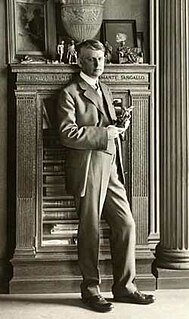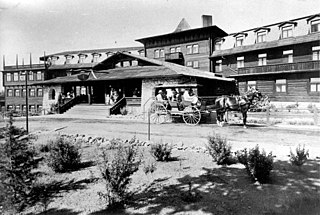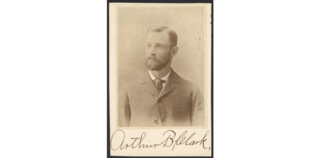Related Research Articles

Bernard Ralph Maybeck was an American architect in the Arts and Crafts Movement of the early 20th century. He was an instructor at University of California, Berkeley. Most of his major buildings were in the San Francisco Bay Area.

Thomas Dolliver Church, also known as Tommy, was a renowned and innovative 20th century landscape architect based in California. He is a nationally recognized as one of the pioneer landscape designers of Modernism in garden landscape design known as the 'California Style'. His design studio was in San Francisco from 1933 to 1977.

William Henry Weeks (1864–1936) was an early 20th-century architect who designed hundreds of buildings including many schools, banks, and libraries. He was best known for the monumental neoclassical style of his public buildings, although he had employed other architectural styles earlier in his career. His first office was in Watsonville, California, but later offices were in various parts of the San Francisco Bay area. Weeks' firm designed structures in over 161 California cities, as well as several buildings in Nevada and Oregon. Weeks was a pioneer in earthquake-resistant construction and, as a result, many of his buildings are still in use.

John Galen Howard was an American architect who began his career in New York before moving to San Francisco, California. He was the principal architect at Howard, Cauldwell & Morgan and employed Julia Morgan early in her architectural career.

Willis Jefferson Polk was an American architect best known for his work in San Francisco, California. For ten years, he was the West Coast representative of D.H. Burnham & Company. In 1915, Polk oversaw the architectural committee for the Panama–Pacific International Exposition (PPIE).
Miller and Pflueger was an architectural firm that formed when James Rupert Miller named Timothy L. Pflueger partner. Pflueger, at the time a rising star of San Francisco's architect community, had begun his architectural career with architecture firm, Miller and Colmesnil sometime in 1907, under the tutelage of James Rupert Miller. Together, Miller and Pflueger designed a number of significant buildings in San Francisco, including the Pacific Telephone & Telegraph Company Building which was the city's tallest skyscraper for four decades.
Ernest Albert Coxhead (1863–1933) was an English-born architect, active in the United States. He was trained in the offices of several English architects and attended the Royal Academy and the Architectural Association School of Architecture, both in London. He moved to California where he was the semi-official architect for the Episcopal Church. At the beginning of his career, Ernest Coxhead focused on designing churches, primarily in the Gothic Revival style. After the mid-1890s, Coxhead focused on residential designs. He was involved in the emergence of the Arts and Crafts style in California. He succeeded in designing residences that incorporated the elements and character of the English country house - shingled, Arts and Crafts style English Vernacular Cottages that combined elements from different periods for dramatic effect.
Anshen and Allen was an international architecture, planning and design firm headquartered in San Francisco with offices in Boston, Columbus, and London. The firm was ranked eighth for sustainable practices, and nineteenth overall in the "Architect 50" published by Architect magazine in 2010. They also ranked twenty-eighth in the top "100 Giants" of Interior Design 2010.

Charles Frederick Whittlesey (1867–1941) was an American architect best known for his work in the American southwest, and for pioneering work in reinforced concrete in California.

Carleton Monroe Winslow, also known as Carleton Winslow Sr., was an American architect, and key proponent of Spanish Colonial Revival architecture in Southern California in the early 20th century.
Thornton Fitzhugh (1864–1933) was an American architect. Among his major works are the Beaux Arts and Romanesque Pacific Electric Building in downtown Los Angeles, California, and a number others which are listed on the U.S. National Register of Historic Places.
Roland Coate was an American architect. He designed many houses and buildings in California, three of which are listed on the National Register of Historic Places.
Walter Danforth Bliss (1874-1956) was an American architect from California. Many of his buildings are listed on the National Register of Historic Places.
John H. Christie (1878–1960) was an American architect who worked for the Southern Pacific Railroad, and was the railroad's Chief Architect from 1924 to 1947.
Frederick Earl Emmons was an American architect. With A. Quincy Jones, he designed many residential properties, including tract houses developed by Joseph Eichler in the Pacific Palisades, Orange, Palo Alto, San Rafael, and commercial buildings in Palm Springs, Pomona, Whittier and Los Angeles. They also designed the Charles E. Young Research Library on the campus of the University of California, Los Angeles (UCLA).
William Baker Faville (1866-1946) was an American architect.

Kenneth A. MacDonald Jr. (1880–1937) was an American architect, known for his residential and commercial work in San Francisco and Los Angeles.

Arthur Bridgman Clark (1866–1948) an American architect, printmaker, author, and professor, as well as the first mayor of Mayfield, California (1855–1925), and first head of Art and Architecture Department at Stanford University. He taught classes at Stanford University from 1893 until 1931.
John Bakewell Jr. (1872–1963) was an American architect, based in San Francisco. With Arthur Brown Jr., he formed the architectural firm of Bakewell and Brown, which designed many San Francisco Bay Area landmarks. Following the dissolution of Bakewell and Brown in 1927, Bakewell formed the new partnership of Bakewell & Weihe with longtime employee Ernest Weihe.
Samuel Newsom was a Canadian-born American architect. Together with his brother Joseph Cather Newsom founded the architecture firm Newsom and Newsom, practicing in Northern and Southern California. Their most celebrated house is the Carson Mansion in Eureka, California.
References
- 1 2 3 "Henry Anthony Minton Sr". Pacific Coast Architect Database (PCAD). Retrieved 13 August 2021.
- ↑ Harvard College Class of 1903 Twenty-fifth Anniversary Report. Norwood, MA: Plimpton Press, pp. 683-684.
- 1 2 3 "Henry A. Minton and John G. Minton Architectural Records and Papers". Columbia University Libraries Archival Collections. Retrieved 13 August 2021.
- ↑ "Pacific Coast Architect Database (PCAD)".
- ↑ Robert Righter, The Battle Over Hetch Hetchy. Oxford, UK: Oxford University Press, pg. 157.
- ↑ Peter Gauvin, "Catholic Parish to Close Historic Church," The Palo Alto Daily. May 6, 1994, pg. 3.